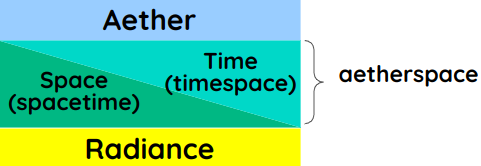The Media of the Spatial Layer
Table of Contents
All changes, motion, and ‘forces’ in the spatial layer happens through the spatial media which have 3 kinds based on the 3 Influences Model:
| Sublayer | Media | Notes |
|---|---|---|
| Upper | Timespace | Time is dominant |
| Middle | Macro Aetherspace | Alternates between time and space (i.e. probabilistic) |
| Lower | Spacetime | Space is dominant |

- Timespace is the sublayer where time predominates and space is minimal.
- Spacetime is the sublayer where space predominates and time is minimal.
- Aetherspace is the layer that combines both timespace and spacetime in order to have an arena for both physical and metaphysical perceptions.

The Various Forces from the Spatial Media
The media of the spatial layer create the various forces:
| Layer | Media | Manifesting Force |
|---|---|---|
| Spatial | mos2 + sos2 | Dark Energy |
| Spatial | mos3 + sos2 | Dark Matter |
| Radiant | mos3 + mor1 | Lensing |
| Radiant | mos3 + mor3 | Magnetism |
| Material | mos3 + mom3 | Gravity |
| Material | som2 | Gluon or Strong Force |
Forces that work in the Spatial and Athereal layers are not detectable by instruments. That is why physicists are unable to find dark matter, dark energy, and gravity.
The Spatial Layer has Different Dynamics in Other Universes
In one of the Essassani transmissions, Bashar mentions a solar system (or galaxy?) that has reverse gravity, allowing creatures to walk on the sky of their planet.
To explain this, we say that in our galaxy, mos3 are arranged with particles facing outwards. This causes material spheres.
However, in other galaxies the mosts might be facing inwards. This would create a reverse gravity wherein creatures would walk on the sky of planets.

Material Superphysics is robust enough to account for the different Physics in other galaxies because it is based on the aether, which is totally flexible.